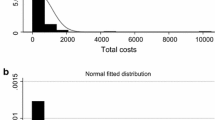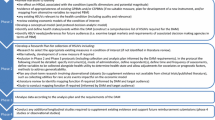Abstract
The aim of cost-utility analysis is to support decision making in healthcare by providing a standardised mechanism for comparing resource use and health outcomes across programmes of work. The focus of this paper is the denominator of the cost-utility analysis, specifically the methodology and statistical challenges associated with calculating QALYs from patient-level data collected as part of a trial. We provide a brief description of the most common questionnaire used to calculate patient level utility scores, the EQ-5D, followed by a discussion of other ways to calculate patient level utility scores alongside a trial including other generic measures of health-related quality of life and condition- and population-specific questionnaires. Detail is provided on how to calculate the mean QALYs per patient, including discounting, adjusting for baseline differences in utility scores and a discussion of the implications of different methods for handling missing data. The methods are demonstrated using data from a trial. As the methods chosen can systematically change the results of the analysis, it is important that standardised methods such as patient-level analysis are adhered to as best as possible. Regardless, researchers need to ensure that they are sufficiently transparent about the methods they use so as to provide the best possible information to aid in healthcare decision making.


Similar content being viewed by others
Notes
Original follow-up points for trial data were 3, 6 and 9 months. These have been extended so as to demonstrate the impact of discounting which only occurs after 1 year.
Note that some issues with the ceiling effect seen in the EQ-5D have been overcome by the development of a 5-level version of the questionnaire [38].
References
Drummond MF, Sculpher MJ, Torrance GW, O’Brien BJ, Stoddart GL. Methods for the economic evaluation of health care programmes. 3rd ed. Oxford: Oxford University Press; 2005.
Torrance GW, Feeny D. Utilities and quality adjusted life years. Int J Technol Assess. 1989;5:559–75.
Richardson G, Manca A. Calculation of quality adjusted life years in the published literature: a review of methodology and transparency. Health Econ. 2004;13:1203–10.
National Institute for Health and Care Excellence (NICE). Guide to the methods of technology appraisal 2013. NICE. 2013. http://publications.nice.org.uk/pmg9. Accessed 24 Mar 2014.
Oemar M, Oppe M. EQ-5D-3L user guide. Basic information on how to use the EQ-5D-3L instrument. Version 5.0. EuroQol. 2013. http://www.euroqol.org/fileadmin/user_upload/Documenten/PDF/Folders_Flyers/EQ-5D-3L_UserGuide_2013_v5.0_October_2013.pdf. Accessed 24 Mar 2014.
Dolan P. Modelling valuations for EuroQol health states. Med Care. 1997;35:1095–108.
Oemar M, Janssen B. EQ-5D-5L user guide. Basic information on how to use the EQ-5D-5L instrument. Version 2.0. EuroQol. 2013. http://www.euroqol.org/fileadmin/user_upload/Documenten/PDF/Folders_Flyers/UserGuide_EQ-5D-5L_v2.0_October_2013.pdf. Accessed 24 Mar 2014.
Brazier JE, Rowen D, Mavranezouli I, Tsuchiya A, Young T, Yang Y, et al. Developing and testing methods for deriving preference-based measures of health from condition-specific measures (and other patient-based measures of outcome). Health Technol Assess. 2012;16:1–114.
Longworth L, Yang Y, Young T, Mulhern B, Hernández Alava M, Mukuria C, et al. Use of generic and condition-specific measures of health-related quality of life in NICE decision-making: a systematic review, statistical modelling and survey. Health Technol Assess. 2014;18:1–224.
Brazier J, Roberts J, Deverill M. The estimation of a preference-based measure of health from the SF-36. J Health Econ. 2002;21:271–92.
Feeny D, Furlong W, Boyle M, Torrance GW. Multi-attribute health status classification systems: Health Utilities Index. Pharmacoeconomics. 1995;7:490–502.
Stevens K, McCabe CJ, Brazier JE, Roberts J. Multi-attribute utility function or statistical inference models: a comparison of health state valuation models using the HUI2 health state classification system. J Health Econ. 2007;26:992–1002.
Stevens K. Valuation of the Child Health Utility 9D Index. Pharmacoeconomics. 2012;30:729–47.
Rowen D, Brazier J, Young T, Gaugris S, Craig BM, King MT, et al. Deriving a preference-based measure for cancer using the EORTC QLQ-C30. Value Health. 2011;14:721–31.
Mulhern B, Rowen D, Jacoby A, Marson T, Snape D, Hughes D, et al. The development of a QALY measure for epilepsy: NEWQOL-6D. Epilepsy Behav. 2012;24:36–43.
Smith SC, Lamping DL, Banerjee S, Harwood R, Foley B, Smith P, et al. Measurement of health-related quality of life for people with dementia: development of a new instrument (DEMQOL) and an evaluation of current methodology. Health Technol Assess. 2005;9:1–93.
Mulhern B, Rowen D, Brazier J, Smith S, Romeo R, Tait R, et al. Development of DEMQOL-U and DEMQOL-PROXY-U: generation of preference-based indices from DEMQOL and DEMQOL-PROXY for use in economic evaluation. Health Technol Assess. 2013;17:1–140.
Bryan S, Hardyman W, Bentham P, Buckley A, Laight A. Proxy completion of EQ-5D in patients with dementia. Qual Life Res. 2005;14:107–18.
Kontodimopoulos N, Aletras VH, Paliouras D, Niakas D. Mapping the cancer-specific EORTC QLQ-C30 to the preference-based EQ-5D, SF-6D, and 15D instruments. Value Health. 2009;12:1151–7.
Kaambwa B, Billingham L, Bryan S. Mapping utility scores from the Barthel index. Eur J Health Econ. 2013;14:231–41.
Longworth L, Rowen D. Mapping to obtain EQ-5D utility values for use in NICE health technology assessments. Value Health. 2013;16:202–10.
Brazier JE, Rowen D, Mavranezouli I, Tsuchiya A, Young T, Yang Y, et al. Developing and testing methods for deriving preference-based measures of health from condition-specific measures (and other patient-based measures of outcome). Health Technol Assess. 2012;16:1–132.
Cooper SA, Morrison J, Allan LM, McConnachie A, Greenlaw N, Melville CA, et al. Practice nurse health checks for adults with intellectual disabilities: a cluster-design, randomised controlled trial. Lancet Psychiatry. 2014;7:511–21.
Miyamoto JM. Quality-adjusted life years (QALY) utility models under expected utility and rank-dependent utility assumptions. J Math Psychol. 1999;43:201–37.
Billingham LJ, Abrams KR, Jones DR. Methods for the analysis of quality-of-life and survival data in health technology assessment. Health Technol Assess. 1999;3:1–152.
Whitehurst DG, Bryan S, Lewis M. Systematic review and empirical comparison of contemporaneous EQ-5D and SF-6D group mean scores. Med Decis Making. 2011;31:E34–44.
Glick HA, Doshe JA, Sonnad SS, Polsky D. Economic evaluation in clinical trials. 2nd ed. Oxford: Oxford University Press; 2007.
NICE. Incorporating health economics. In: Methods for the development of NICE public health guidance (3rd ed). NICE. 2012. http://publications.nice.org.uk/methods-for-the-development-of-nice-public-health-guidance-third-edition-pmg4/incorporating-health-economics. Accessed 24 Mar 2014.
Committee for Medicinal Products for Human Use (CHMP). Guideline on adjustment for baseline covariates. European Medicines Agency. 2013. http://www.ema.europa.eu/docs/en_GB/document_library/Scientific_guideline/2013/06/WC500144946.pdf. Accessed 17 June 2014.
Manca A, Hawkins N, Sculpher MJ. Estimating mean QALYs in trial-based cost-effectiveness analysis: the importance of controlling for baseline utility. Health Econ. 2005;14:487–96.
Carpenter JR, Kenward MG. Missing data in randomised controlled trials—a practical guide. Birmingham: National Institute for Health Research; 2008. http://missingdata.lshtm.ac.uk/downloads/rm04_jh17_mk.pdf. Accessed 24 Mar 2014.
Brueton VC, Tierney JF, Stenning S, Meredith S, Harding S, Nazareth I, et al. Strategies to improve retention in randomised trials: a Cochrane systematic review and meta-analysis. BMJ Open. 2013;4:e003821.
Little RJ, Rubin DB. Statistical analysis with missing data. 2nd ed. New York: Wiley; 2002.
Noble SM, Hollingworth W, Tilling K. Missing data in trial-based cost-effectiveness analysis: the current state of play. Health Econ. 2012;21:187–200.
Eekhout I, de Boer RM, Twisk JW, de Vet HC, Heymans MW. Missing data: a systematic review of how they are reported and handled. Epidemiology. 2012;23:729–32.
White IR, Royston P, Wood AM. Multiple imputation using chained equations: issues and guidance for practice. Stat Med. 2011;30:377–99.
Willan AR, Briggs AH, Hoch JS. Regression methods for covariate adjustment and subgroup analysis for non-censored cost-effectiveness data. Health Econ. 2004;13:461–75.
Janssen MF, Pickard AS, Golicki D, Gudex C, Niewada M, Scalone L, et al. Measurement properties of the EQ-5D-5L compared to EQ-5D-3L across eight patient groups: a multi country study. Qual Life Res. 2012;22:1717–27.
Acknowledgments
We would like to thank Professor Sally-Anne Cooper and colleagues at the University of Glasgow for allowing us to use their data as part of this analysis. The data were amended for demonstration purposes and so that no comparison can be drawn between the results of this analysis and any results of the trial.
Conflict of interest
No funding was received for the analysis or writing of this paper. None of the authors have any conflicts of interest to report.
Individual author contributions
All authors contributed to the original idea for the paper and have provided written contributions to the paper including edits to draft versions. RMH wrote the original draft, conducted data analysis and coordinated additional edits to the paper. GB contributed to the section on missing data in addition to comments and edits on the paper. TB contributed to sections on alternatives to the EQ-5D in addition to comments and edits on the paper. NF, SM and JR provided expertise on the overall ideas and content of the paper in addition to edits and comments on each draft of the paper.
RMH will act as overall guarantor for the work.
Author information
Authors and Affiliations
Corresponding author
Rights and permissions
About this article
Cite this article
Hunter, R.M., Baio, G., Butt, T. et al. An Educational Review of the Statistical Issues in Analysing Utility Data for Cost-Utility Analysis. PharmacoEconomics 33, 355–366 (2015). https://doi.org/10.1007/s40273-014-0247-6
Published:
Issue Date:
DOI: https://doi.org/10.1007/s40273-014-0247-6




